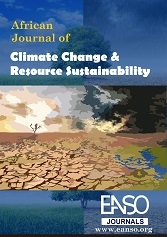Overtime Modelled Climate Variability Effect in Roysambu Sub-County in Nairobi Kenya: A Retrospective Analysis
Abstract
The effect of climate variability is unprecedented, affecting an array of ecosystems globally. Intensified effects of rainfall and temperature variations are affecting urbanised ecosystems where urban sprawl has ramified. This study looks at modelled retrospective climate variability changes in the Roysambu area, an urbanised suburb in Nairobi County, Kenya. The study aimed to ascertain the changes in rainfall and temperature in the past 30 years. From the simple regression analysis, the total annual average rainfall has slightly increased in the area (y = 0.5235x + 72.037, R2 = 0.0618). There were changes in temperature where the maximum average temperature had increased by 0.5 °C with a simple regression model (y = 0.012x + 0.6281, R2 = 0.0814). From the findings, climate variability has been experienced in the area through simple regression model retrospective analysis over time
Downloads
References
Ayugi, B., Tan, G., Ullah, W., Boiyo, R., & Ongoma, V. (2019). Inter-comparison of remotely sensed precipitation datasets over Kenya during 1998–2016. Atmospheric Research, 225, 96-109.
Bathiany, S., Dakos, V., Scheffer, M., & Lenton, T. M. (2018). Climate models predict increasing temperature variability in poor countries. Science Advances, 4(5), eaar5809. https://doi.org/10.1126/sciadv.aar5809
Camberlin, P. (2018). Climate of Eastern Africa. In Oxford Research Encyclopedia of Climate Science. Oxford University Press.
Douglas, I. (2017). Flooding in African cities, scales of causes, teleconnections, risks, vulnerability and impacts. International Journal of Disaster Risk Reduction, 26, 34-42.
Gathungu, J. G. (2019). Environmental Impact Assessment Study Report for the Proposed two Blocks Residential Units Development on Plot Lr No: 10119/4-Next to Garden City Mall, Off Thika Super Highway, Kasarani Sub County, Nairobi County.
Georgescu, M., Broadbent, A. M., Wang, M., Krayenhoff, E. S., & Moustaoui, M. (2021). Precipitation response to climate change and urban development over the continental United States. Environmental Research Letters, 16(4), 044001.
Govender, T., Dube, T., & Shoko, C. (2022). Remote sensing of land use-land cover change and climate variability on hydrological processes in Sub-Saharan Africa: Key scientific strides and challenges. Geocarto International, 1-25. https://doi.org/10.1080/10106049.2022.2044175
Hawkins, E., & Sutton, R. (2016). Connecting climate model projections of global temperature change with the real world. Bulletin of the American Meteorological Society, 97(6), 963-980. https://doi.org/10.1175/BAMS-D-14-00254.1
IEBC. (2013). Electoral Boundaries. Nairobi, Kenya: Kenya Gazette.
Ji, F., Wu, Z., Huang, J., & Chassignet, E. P. (2014). Evolution of land surface air temperature trend. Nature Climate Change, 4(6), 462-466. https://doi.org/10.1038/nclimate2223
Keane, J., Mendez-Parra, M., Pettinotti, L., & Sommer, L. (2021). The climate and trade nexus in Africa: Climate change and the transformation of African trade. ODI Report. https://www.odi.org/publications/17403-climate-and-trade-nexus-africa-climate-change-and-transformation-african-trade
Khan, M. A. (2022). Vision of a Sustainable, Smart, and Resilient City. In Cities and Mega Risks (pp. 295-338). Springer, Cham.
Kimuku, C. W., & Ngigi, M. M. (2017). Study of urban heat island trends to aid in urban planning in Nakuru County-Kenya. International Journal of Urban Sciences, 21(1), 94-110. https://doi.org/10.1080/12265934.2017.1352817
Ndolo, I. J., Nzioka, J. M., Oludhe, C., Ng’ang’a, J. K., & Odingo, R. S. (2018). Influence of urbanisation on minimum and maximum temperature characteristics over Nairobi City. International Journal of Climatology, 38(14), 5147-5160. https://doi.org/10.1002/joc.5716
Ngare, I. O., Koske, J. K., Muriuki, J. N., Chitechi, E. W., & Gathuku, G. N. (2020). Urban climate variability trend in the coastal region of Mombasa Kenya. African Journal of Environmental Science and Technology, 14(8), 214-221. https://doi.org/10.5897/AJEST2019.2773
Nicholson, S. E. (2019). A review of climate dynamics and climate variability in Eastern Africa. In M. J. Leng & R. C. Kay (Eds.), The limnology, climatology and paleoclimatology of the East African lakes (pp. 25-56). Springer.
National Research Council. (2014). Wetlands: Characteristics and Boundaries. National Academies Press.
Nyika, J. (2017). Situational analysis of Nairobi River Basin (NRB). Water Practice and Technology, 12(3), 589-603.
UNEP. (2017). Integrated Monitoring Guide for Sustainable Development Goal 6 on Water and Sanitation: Good practices for country monitoring systems (Version 6). United Nations Environment Programme.
Williams, A. P., Seager, R., Abatzoglou, J. T., Cook, B. I., Smerdon, J. E., & Cook, E. R. (2015). Contribution of anthropogenic warming to California drought during 2012–2014. Geophysical Research Letters, 42(16), 6819-6828.
Zhongming, Z., Linong, L., Xiaona, Y., Wangqiang, Z., & Wei, L. (2021). AR6 climate change 2021: The physical science basis. Intergovernmental Panel on Climate Change.
Zhou, T. (2021). New physical science behind climate change: What does IPCC AR6 tell us? The Innovation, 2(4), 100171.
Copyright (c) 2023 Roselyn Gathoni Ngigi, James Kibii Koske, PhD, Cecilia Gichuki, PhD

This work is licensed under a Creative Commons Attribution 4.0 International License.




























